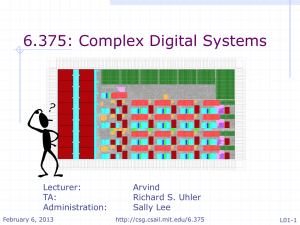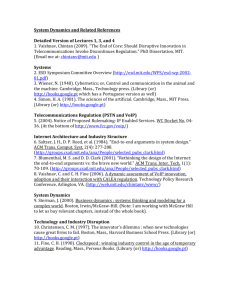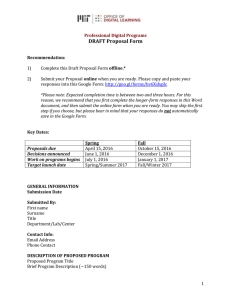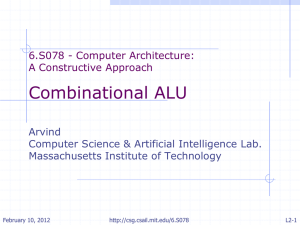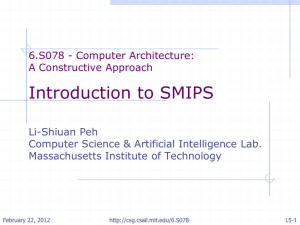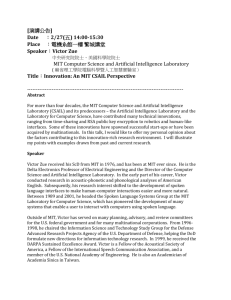L01-Introduction - Computation Structures Group
advertisement
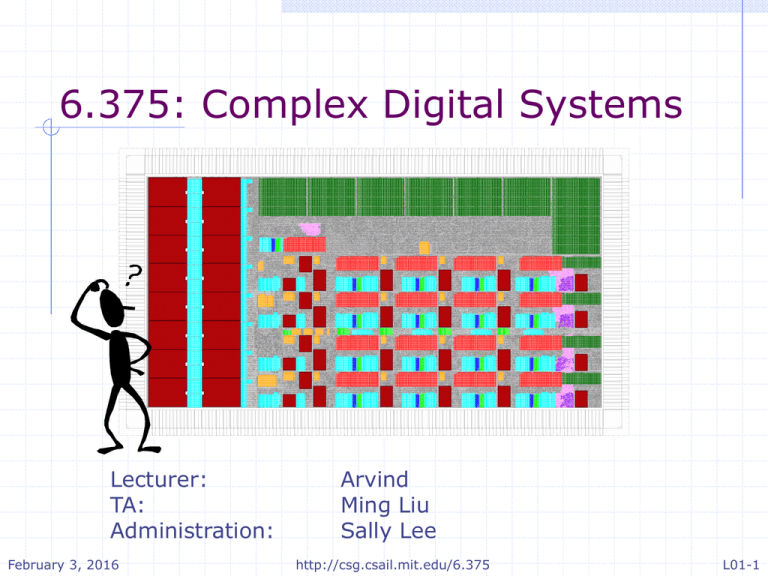
6.375: Complex Digital Systems Lecturer: TA: Administration: February 3, 2016 Arvind Ming Liu Sally Lee http://csg.csail.mit.edu/6.375 L01-1 Why take 6.375 Something new and exciting as well as useful Fun: Design systems that you never thought you could design in a course made possible by large FPGAs and Bluespec You will also discover that is possible to design complex digital systems with little knowledge of circuits February 3, 2016 http://csg.csail.mit.edu/6.375 L01-2 New, exciting and useful … February 3, 2016 http://csg.csail.mit.edu/6.375 L01-3 Wide Variety of Products Rely on ASICs ASIC = Application-Specific Integrated Circuit February 3, 2016 http://csg.csail.mit.edu/6.375 L01-4 What’s required? ICs with dramatically higher performance, optimized for applications Source: http://www.intel.com/technology/silicon/mooreslaw/index.htm and at a size and power to deliver mobility cost to address mass consumer markets February 3, 2016 http://csg.csail.mit.edu/6.375 L01-5 Cell Phones: Samsung Galaxy S III April 2012 Quad core ARM is just one of the complex blocks 16GB NAND flash February 3, 2016 Samsung Exynos Quad: - quad-core A9 - 1GB DDR2 (low power) power consumption <1W - Multimedia processor - ... http://csg.csail.mit.edu/6.375 L01-6 Server microprocessors also need specialized blocks compression/decompression encryption/decryption intrusion detection and other security related solutions Dealing with spam Self diagnosing errors and masking them … February 3, 2016 http://csg.csail.mit.edu/6.375 L01-7 Real power saving implies specialized hardware H.264 video decoder implementations in software vs. hardware the power/energy savings could be 100 to 1000 fold but our mind set is that hardware design is: Difficult, risky Increases time-to-market Inflexible, brittle, error prone, ... Difficult to deal with changing standards, … New design flows and tools can change this mind set February 3, 2016 http://csg.csail.mit.edu/6.375 L01-8 Will multicores reduce the need for new hardware? Unlikely – because of power and performance 64-core Tilera February 3, 2016 http://csg.csail.mit.edu/6.375 L01-9 SoC & Multicore Convergence: more application specific blocks Applicationspecific processing units On-chip memory banks Generalpurpose processors Structured onchip networks February 3, 2016 http://csg.csail.mit.edu/6.375 L01-10 To reduce the design cost of SoCs we need … Extreme IP reuse “Intellectual Property” Multiple instantiations of a block for different performance and application requirements Packaging of IP so that the blocks can be assembled easily to build a large system (black box model) Architectural exploration to understand cost, power and performance tradeoffs Full system simulations for validation and verification February 3, 2016 http://csg.csail.mit.edu/6.375 L01-11 Hardware design today is like programming was in the fifties, i.e., before the invention of high-level languages February 3, 2016 http://csg.csail.mit.edu/6.375 L01-12 Programmers had to know many detail of their computer IBM 650 (1954) An IBM 650 Instruction: 60 1234 1009 Can you program a computer without knowing , for • example, “Load thehow contents locationit1234 many of registers has? into the distribution; put it also into the upper accumulator; 1950s set lower accumulator to zero; and then go to reaction location 1009 for the next instruction.” Fortran changed this mind set (1956) February 3, 2016 http://csg.csail.mit.edu/6.375 L01-13 For designing complex SoCs deep circuits knowledge is secondary Using modern high-level hardware synthesis tools like Bluespec requires computer science training in programming and architecture rather than circuit design February 3, 2016 http://csg.csail.mit.edu/6.375 L01-14 Bluespec A new way of Bluespec expressing behavior A formal method of composing modules with parallel interfaces (ports) Compiler manages muxing of ports and associated control Powerful and zero-cost parameterization of modules Encapsulation of C and Verilog codes using Bluespec wrappers Helps Transaction Level modeling Smaller, simpler, clearer, more correct code not just simulation, synthesis as well February 3, 2016 http://csg.csail.mit.edu/6.375 L01-15 WiFi: 64pt @ 0.25MHz IP Reuse via parameterized modules Example based WiMAX: 256ptOFDM @ 0.03MHz protocols MAC TX Controller Scrambler FEC Encoder Interleaver Mapper Pilot & Guard Insertion IFFT CP Insertion MAC RX Controller DeScrambler FEC Decoder DeInterleaver DeMapper Channel Estimater FFT S/P WUSB: 128pt 8MHz D/A Synchronizer A/D standard specific 4+1 potential reuse Convolutional WiFi:x7+x Reusable algorithm with different parameter settings WiMAX: Reed-Solomon x15+x14+1 85% reusable code between WiFi and WiMAX Different throughput requirements From WiFi to WiMAX in 4 weeks WUSB: Turbo x15+x14+1 Different algorithms (Alfred) Man Cheuk Ng, … February 3, 2016 http://csg.csail.mit.edu/6.375 L01-16 High-level Synthesis from Bluespec Bluespec SystemVerilog source First simulate Second run on FPGAs Bluespec Compiler We won’t explore the chip design path Verilog 95 RTL Bluesim Cycle Accurate Verilog sim RTL synthesis VCD output Debussy Visualization gates Power estimation tool Place & Route FPGA Tapeout February 3, 2016 http://csg.csail.mit.edu/6.375 L01-17 Chip Design Styles Custom and Semi-Custom Hand-drawn transistors (+ some standard cells) High volume, best possible performance: used for most advanced microprocessors Standard-Cell-Based ASICs High volume, moderate performance: Graphics chips, network chips, cell-phone chips Field-Programmable Gate Arrays Prototyping Low volume, low-moderate performance applications Different design styles have vastly different costs February 3, 2016 http://csg.csail.mit.edu/6.375 L01-18 Exponential growth: Moore’s Law Intel 8080A, 1974 3Mhz, 6K transistors, 6u Intel 486, 1989, 81mm2 50Mhz, 1.2M transistors, .8u Intel 8086, 1978, 33mm2 10Mhz, 29K transistors, 3u Intel Pentium, 1993/1994/1996, 295/147/90mm2 66Mhz, 3.1M transistors, .8u/.6u/.35u Shown with approximate relative sizes February 3, 2016 Intel 80286, 1982, 47mm2 12.5Mhz, 134K transistors, 1.5u Intel 386DX, 1985, 43mm2 33Mhz, 275K transistors, 1u Intel Pentium II, 1997, 203mm2/104mm2 300/333Mhz, 7.5M transistors, .35u/.25u http://www.intel.com/intel/intelis/museum/exhibit/hist_micro/hof/hof_main.htm http://csg.csail.mit.edu/6.375 L01-19 Intel Ivy Bridge 2012 Quad core Quad-issue out-of-order superscalar processors Caches: L1 64 KB/core L2 256 KB/core L3 6 MB shared 22nm technology 1.4 Billion transistors 3.4 GHz clock frequency Power > 17 Watts (under clocked) Could fit over 1200 486 processors on same size die. February 3, 2016 http://csg.csail.mit.edu/6.375 L01-20 But Design Effort is Growing Nvidia Graphics Processing Units 120 Transistors (M) 100 80 Relative staffing on back-end 9x growth in back-end staff Relative staffing on front-end 5x growth in front-end staff 60 40 20 2002 2002 2001 2001 2000 1999 1998 1997 1996 1995 1993 0 Front-end is designing the logic (RTL) Back-end is fitting all the gates and wires on the chip; meeting timing specifications; wiring up power, ground, and clock February 3, 2016 http://csg.csail.mit.edu/6.375 L01-21 Design Cost Impacts Chip Cost An Altera study Non-Recurring Engineering (NRE) costs for a 90nm ASIC is ~ $30M 59% chip design (architecture, logic & I/O design, product & test engineering) 30% software and applications development 11% prototyping (masks, wafers, boards) If we sell 100,000 units, NRE costs add $30M/100K = $300 per chip! Hand-crafted IBM-Sony-Toshiba Cell microprocessor achieves 4GHz in 90nm, but at the development cost of >$400M Alternative: Use FPGAs February 3, 2016 http://csg.csail.mit.edu/6.375 L01-22 Field-Programmable Gate Arrays (FPGAs) Arrays mass-produced but programmed by customer after fabrication Can be programmed by loading SRAM bits, or loading FLASH memory Each cell in array contains a programmable logic function Array has programmable interconnect between logic functions Overhead of programmability makes arrays expensive and slow as compared to ASICs However, much cheaper than an ASIC for small volumes because NRE costs do not include chip development costs (only include programming) February 3, 2016 http://csg.csail.mit.edu/6.375 L01-23 FPGA Pros and Cons Advantages Dramatically reduce the cost of errors Little physical design work Remove the reticle costs from each design Disadvantages (as compared to an ASIC) [Kuon & Rose, FPGA2006] February 3, 2016 Switching power around ~12X worse Performance up 3-4X worse Still requires Area 20-40X greater tremendous design effort at RTL level http://csg.csail.mit.edu/6.375 L01-24 FPGAs: a new opportunity “Big” FPGAs have become widely available A multicore can be emulated on one FPGA but the programming model is RTL and not too many people design hardware Enable the use of FPGAs via Bluespec February 3, 2016 http://csg.csail.mit.edu/6.375 L01-25 6.375 Philosophy Effective abstractions to reduce design effort High-level design language rather than logic gates Control specified with Guarded Atomic Actions rather than with finite state machines Guarded module interfaces to systematically build larger modules by the composition of smaller modules Design discipline to avoid bad design points Decoupled units rather than tightly coupled state machines Design space exploration to find good designs Architecture choice has largest impact on solution quality We learn by doing actual designs February 3, 2016 http://csg.csail.mit.edu/6.375 L01-26 6.375 Complex Digital Systems: past projects Optical flow in Harvard Robo Bee project Spinal Codes for Wireless Communication Beat tracker H.265 Motion Estimation for video compression A chip was fabricated later Hard Viterbi Decoder Video motion magnification RSA Programmable packet filter for 1Gbps stream 6 weeks of individual lab work + 6-week group projects Fun: Design systems that you thought you would never design in a course February 3, 2016 http://csg.csail.mit.edu/6.375 L01-27 Resources – beyond TA, mentors and classmates Lecture slides (with animation) Make sure you sure you understand the lectures before exploring other materials http://csg.csail.mit.edu/6.375/handouts.html Computer Architecture: A Constructive Approach, Arvind, Rishiyur S. Nikhil, Joel S. Emer, and Murali Vijayaraghavan (2012) Uses Executable and Synthesizable processor Specifications BSV By Example, Rishiyur S. Nikhil and Kathy R. Czeck (2010) Bluespec System Verilog Reference manual You will need to refer to this often Bluespec System Verilog Users guide February 3, 2016 How to use all the tools for developing BSV programs http://csg.csail.mit.edu/6.375 L01-28
